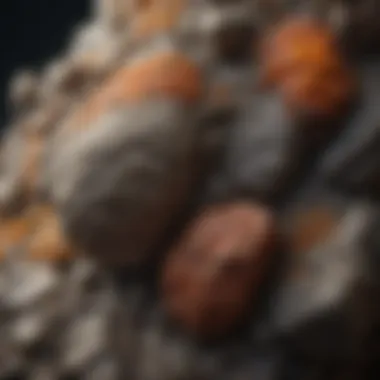Unveiling the Educational Advantages of Rock Samples for Schools


Rock and Fossil Identification
Rock and fossil identification is a fundamental skill for enthusiasts and educators alike. Understanding the types of rocks and fossils is crucial for further exploration. Rocks can be classified into three main types: igneous, sedimentary, and metamorphic. Each type possesses distinct characteristics that aid in identification, such as color, texture, and composition. Fossils, on the other hand, offer glimpses into prehistoric lifeforms. Recognizing key features such as shape, size, and imprint patterns assists in accurate identification. To aid in this process, tools like magnifying glasses, hardness picks, and acid tests are commonly used to analyze mineral composition and hardness.
Collecting Tips and Techniques
Embarking on a rock and fossil collecting journey requires knowledge of best practices to ensure a fruitful experience. Selecting prime collecting sites is essential, as different rock formations yield diverse specimens. Geological maps, online databases, and local geological societies can guide collectors to optimal locations. When extracting specimens, practicing safe techniques is paramount to preserve both the specimens and the environment. Utilizing tools such as rock hammers, chisels, and brushes aids in safely isolating and collecting specimens without causing damage to the surrounding area.
Preservation and Display
Preservation techniques are vital for maintaining the integrity and longevity of collected rocks and fossils. Using methods such as fossilization, casting, and stabilization can protect delicate specimens from deterioration. Proper storage includes utilizing acid-free paper, archival boxes, and climate-controlled environments to prevent decay due to moisture and temperature fluctuations. For creative display ideas, enthusiasts can showcase their collections in shadow boxes, museum-quality displays, or custom-designed shelves to highlight the beauty and diversity of their specimens.
Geological Insights
Delving into geological insights offers a deeper appreciation of the Earth's history and processes. Studying geological formations provides valuable insight into the Earth's evolution and the forces that have shaped its landscape over millions of years. Rocks and fossils hold historical significance, acting as time capsules of ancient ecosystems and past climates. Notable discoveries in the field of geology have revolutionized our understanding of Earth's history, such as the findings of transitional fossils and geological events like mass extinctions. By exploring geological insights, enthusiasts can unravel the mysteries of the planet's past and present.
Introduction
In the realm of education, the utilization of rock samples serves as a pivotal tool in enhancing the learning experience for students. This section of the article will delve deep into the significance of incorporating rock samples within educational settings, particularly schools. By leveraging hands-on experiences with rock samples, students not only gain a profound understanding of geology, earth sciences, and environmental studies but also develop a nuanced appreciation for the intricate processes that shape the world around them. The introduction sets the stage for exploring how rock samples can revolutionize traditional teaching methods, igniting curiosity and engagement among learners.
Overview of Rock Samples in Education
Importance of Practical Learning Experiences
Elevating the learning experience through practical applications is a cornerstone of modern education. The significance of practical learning experiences lies in their ability to bridge the gap between theoretical knowledge and real-world application. Within the context of utilizing rock samples, students engage in tangible experiences that deepen their comprehension of geological concepts. By physically interacting with rocks, students not only witness geological phenomena firsthand but also develop critical thinking skills through observation and analysis. This hands-on approach cultivates a deeper connection to the subject matter and fosters a lasting interest in earth sciences.
Integration of Rock Samples in Curricula
The integration of rock samples in curricula offers a multidimensional approach to teaching that resonates with diverse learning styles. By incorporating rock samples across various subjects, educators can infuse geology and earth sciences into disciplines such as geography and history, enriching the learning experience and promoting interdisciplinary connections. The unique feature of integrating rock samples lies in its ability to provide a tactile understanding of abstract concepts, making learning more accessible and engaging for students. While the advantages of integrating rock samples are plentiful, it is essential to consider potential challenges such as resource management and logistical constraints to ensure effective implementation.
Benefits of Using Rock Samples in Schools
Rock samples play a crucial role in enhancing educational experiences within school settings. By integrating rock samples into the curriculum, students can delve deep into the world of geology, earth sciences, and environmental studies. The tactile nature of rock samples offers a unique hands-on learning opportunity that supplements theoretical knowledge and fosters a profound understanding of geological concepts. Moreover, the use of rock samples in schools ignites curiosity, encourages exploration, and promotes environmental awareness among students.


Enhanced Learning Opportunities
Hands-on Exploration of Geological Features
Hands-on exploration of geological features provides students with the opportunity to physically interact with rocks, minerals, and fossils. This tactile engagement not only enhances the learning experience but also allows students to observe and analyze geological formations up close. By touching and examining different types of rocks firsthand, students gain a deeper appreciation for the diversity and unique characteristics of Earth's surface.
Visual and Tactile Engagement
Visual and tactile engagement through rock samples stimulates sensory perception and facilitates experiential learning. This immersive approach allows students to visually inspect the textures, colors, and structures of various rocks, aiding in their understanding of geological processes. Furthermore, the tactile nature of rock samples promotes kinesthetic learning, catering to diverse learning styles.
Real-World Application of Theoretical Knowledge
The real-world application of theoretical knowledge using rock samples bridges the gap between classroom learning and practicality. By analyzing and interpreting rock samples, students can apply theoretical concepts to real geological scenarios. This hands-on application nurtures critical thinking skills, problem-solving abilities, and a deeper comprehension of geological phenomena.
Fostering Curiosity and Interest
Stimulating Scientific Inquiry
The interactive nature of rock samples stimulates scientific inquiry and nurtures a spirit of exploration among students. As they engage with rocks and fossils, students are encouraged to ask questions, form hypotheses, and conduct experiments, fostering a culture of scientific curiosity within the classroom.
Encouraging Exploration and Discovery
Rock samples serve as catalysts for exploration and discovery, prompting students to investigate the geological mysteries hidden within each specimen. By encouraging hands-on exploration, students can unearth the secrets embedded in rocks, fostering a sense of wonder and discovery for the Earth's geological history.
Developing a Passion for Earth Sciences
Through hands-on interactions with rock samples, students develop a passion for earth sciences and geological studies. The immersive nature of exploring rocks ignites a spark of interest in the natural world, inspiring students to delve deeper into the complexities of Earth's formation, evolution, and geological processes.
Promoting Environmental Awareness
Understanding Local Geological Formations
Rock samples help students understand the intricacies of local geological formations and landscapes. By examining rocks native to their region, students gain insights into the geological history of their surroundings, fostering a deeper connection to the environment and promoting local geology awareness.
Highlighting Conservation Efforts


The study of rock samples also highlights the importance of conservation efforts and sustainable practices. By analyzing the impact of human activities on geological formations, students develop an awareness of environmental conservation and the significance of preserving Earth's natural resources for future generations.
Integration of Rock Samples in School Curriculum
In the realm of educational settings, the integration of rock samples within the school curriculum holds immense importance. By incorporating rock samples across various subjects, schools offer students a unique opportunity to delve into the practical applications of geology and earth sciences. This integration goes beyond textbooks, providing hands-on experiences that enhance learning and foster a deeper understanding of our planet's geological processes. Moreover, it encourages curiosity and critical thinking skills, laying the foundation for a lifelong appreciation of Earth's natural wonders.
Incorporating Rock Samples Across Subjects
Geology and Earth Sciences
Geology and earth sciences play a pivotal role in the integration of rock samples in school curriculum. This subject offers students a comprehensive view of our planet's geological composition, allowing them to study the Earth's history through its rocks and minerals. By incorporating rock samples in geology classes, students gain practical insights into rock classification, mineral identification, and the interpretation of geological formations. This hands-on approach not only solidifies theoretical knowledge but also instills a sense of curiosity and wonder about the Earth's natural processes.
Geography and Natural Resources
When it comes to geography and natural resources, rock samples serve as valuable tools for understanding the Earth's topography, land formations, and mineral distribution. By studying rock samples, students can connect theoretical concepts with real-world examples, enhancing their spatial awareness and geological literacy. Geography classes enriched with rock samples encourage students to explore the impact of geological processes on the environment, fostering an appreciation for the Earth's natural resources and the importance of conservation efforts.
History and Evolution of Landscapes
Exploring the history and evolution of landscapes through rock samples provides students with a unique perspective on how geological forces shape the world around us. By analyzing rock formations, students can unravel the mysteries of Earth's past, from ancient sediment layers to the formation of majestic mountain ranges. This interdisciplinary approach blends history, geography, and geology, offering students a holistic understanding of how landscapes evolve over time and the profound impact of geological processes on our planet.
Practical Applications in Geology
Classification of Rocks and Minerals
The classification of rocks and minerals is a fundamental aspect of geology that comes to life through the study of rock samples. By examining the physical properties and chemical compositions of various rocks, students learn to categorize and identify different rock types. This hands-on experience not only strengthens their analytical skills but also deepens their understanding of the Earth's geological diversity. The practical application of rock classification instills a sense of precision and attention to detail, essential skills for aspiring geologists and earth scientists.
Interpretation of Geological Processes
Interpreting geological processes through the analysis of rock samples offers students a window into the Earth's geological history. By studying rock formations, students can reconstruct past environments, trace the effects of tectonic movements, and interpret the mechanisms behind natural phenomena such as fossilization and erosion. This critical thinking exercise challenges students to connect theoretical concepts with empirical evidence, fostering a deeper appreciation for the dynamic nature of Earth's geology. Through hands-on engagement with rock samples, students develop the interpretative skills necessary to unravel the secrets buried within the Earth's rocky layers.
Engaging Educational Activities
Rock Identification Challenges


Rock identification challenges provide students with a stimulating and interactive way to hone their geological knowledge and observational skills. By presenting students with a variety of rock samples, each with distinct characteristics, educators can encourage students to apply their understanding of rock classification in a practical setting. These challenges promote active learning, critical thinking, and collaborative problem-solving, fostering a deeper appreciation for the complexities of Earth's geological heritage.
Field Trips to Geological Sites
Field trips to geological sites offer students a firsthand experience of the Earth's geological wonders, immersing them in real-world examples of geological processes. By observing rock formations in their natural habitat, students can witness the effects of weathering, sedimentation, and volcanic activity up close. These field trips not only enhance theoretical knowledge but also ignite a sense of wonder and curiosity about the Earth's geological history. Guided by expert geologists, students have the opportunity to engage with the environment, ask questions, and deepen their connection to the natural world.
Strategies for Sourcing Rock Samples
Local Geology Clubs and Organizations
Collaboration with Geological Experts
Collaborating with geological experts offers a profound opportunity for schools aiming to incorporate rock samples into their educational programs. By partnering with experienced professionals in the field of geology, educators can benefit from expert knowledge, guidance, and access to a wide range of geological specimens. This collaborative effort not only enriches the learning experience for students but also fosters a deeper understanding of geological concepts through real-world applications. The expertise provided by geological experts can elevate the quality of educational activities and offer unique insights that may not be readily available within a classroom setting.
Accessing Regional Rock Collections
Accessing regional rock collections serves as a valuable resource for schools seeking to enhance their earth science curriculum. By tapping into local geological repositories, educators can access a diverse array of rock samples that are characteristic of the region's geological history. This direct engagement with local rock collections allows students to study rocks and minerals that have significant geological importance within their own geographic context. Moreover, accessing regional rock collections encourages students to appreciate the geological heritage of their surroundings and promotes a sense of interconnectedness with the earth's history and natural processes.
Online Resources and Suppliers
Virtual Rock Sample Kits
Incorporating virtual rock sample kits into the educational framework offers a modern and innovative approach to engaging students in earth science studies. Virtual rock sample kits provide a digital platform where students can explore various types of rocks and minerals in a dynamic and interactive manner. This digital resource allows for virtual manipulation and examination of rock samples, enhancing the visualization abilities of students and enabling them to delve deeper into the characteristics of different geological specimens. Virtual rock sample kits are particularly advantageous for distance learning scenarios and can supplement traditional hands-on activities by providing additional opportunities for exploration and discovery.
Specialized Educational Suppliers
Relying on specialized educational suppliers for rock samples ensures access to high-quality and tailored geological materials for educational purposes. These suppliers offer a wide selection of rock samples, ranging from common igneous, sedimentary, and metamorphic rocks to rare and specialized geological specimens. By acquiring rock samples from specialized suppliers, schools can guarantee the authenticity and educational value of the specimens, enhancing the overall learning experience for students. Additionally, specialized suppliers often provide detailed information on the geological origins and properties of the rock samples, enriching the educational content and relevance of the earth science curriculum.
Conclusion
In delving deep into the exploration of the benefits of rock samples for schools, it becomes evident that incorporating such samples into educational settings offers a multitude of advantages. The significance goes beyond traditional classroom learning, extending into practical applications that enrich students' understanding of geology, earth sciences, and environmental studies. By engaging with rock samples, students not only enhance their academic knowledge but also develop a profound connection with the natural world and the intricate geological processes that shape it. The hands-on experience provided by rock samples transcends theoretical teachings, allowing students to immerse themselves in a tangible learning environment that fosters curiosity and critical thinking.
Empowering Students Through Rock Samples
Enhancing scientific literacy
Discussing the enhancement of scientific literacy through the utilization of rock samples is paramount in achieving the overall educational goals set forth in this article. By immersing students in hands-on geological exploration, scientific literacy is not only promoted but also deeply ingrained within their educational journey. The key characteristic of enhancing scientific literacy lies in its ability to bridge theoretical knowledge with practical experience, creating a holistic learning approach that resonates with students. This choice is particularly beneficial for this article as it aligns perfectly with the ethos of promoting experiential education. The unique feature of enhancing scientific literacy is its capacity to cultivate analytical skills and a deeper understanding of scientific concepts through direct engagement with geological specimens. The advantages of this approach in this article include fostering a lifelong appreciation for scientific inquiry and nurturing a generation of critical thinkers well-versed in geological sciences.
Instilling a lifelong curiosity for geology
When considering instilling a lifelong curiosity for geology through the exploration of rock samples, it becomes apparent that this aspect plays a crucial role in captivating students' interest and passion for the subject. The key characteristic lies in sparking a sense of wonder and exploration within students, driving them to continuously seek knowledge and understanding about the intricate world of geology. This choice is highly valuable for this article as it encourages a lasting fascination with the Earth's geological processes and formations. The unique feature of instilling a lifelong curiosity for geology is its capacity to transcend traditional learning boundaries and instill a curiosity that extends far beyond the classroom. By nurturing this curiosity, students are inspired to pursue further studies in geology and related fields, opening doors to future educational and career opportunities. The advantages of this approach in this article include creating a community of lifelong learners passionate about geology and committed to environmental stewardship for years to come.







